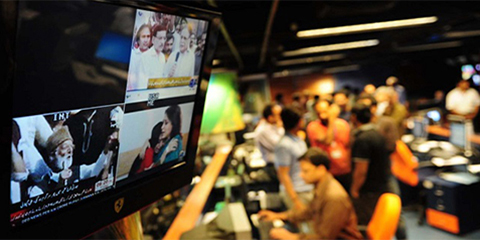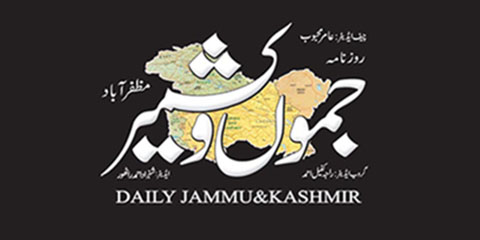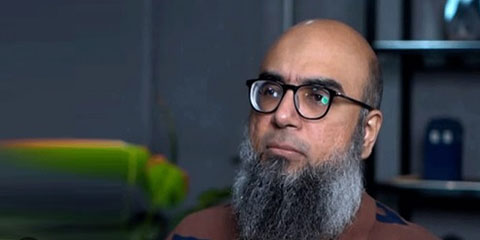JournalismPakistan.com | Published May 10, 2012 | Steve Manuel
Join our WhatsApp channel
A newsroom never changes, I have been told. Maybe, a few alterations here and there, some upgrading, refurbishing…but basically almost everything stays the same and it doesn’t matter what part of the world it is in.
I’ve been in a few newsrooms in my time in Pakistan and elsewhere and I would like to disagree. If you’re talking furniture, basic equipment and general newsroom staff hierarchy, then of course yes. But if you are talking about the nature of the beast, then it’s a big no.
The best newsroom I have had the pleasure of working in was the Dubai TV newsroom in Media City, Dubai. It was simply amazing. Once a CNN crew from Atlanta came and I actually witnessed their collective jaws drop. Housed under one massive roof with five open studios and state of the art equipment it was indeed impressive.
With multiple booms, dozens of cameras, numerous editing suites, work stations and a producer’s station that would match a 777 or all its gadgetry, to work here was a dream come true.
And it were not just the surroundings that were amazing, but my boss, my colleagues, fellow workers and the prevailing professionalism and work ethic made this a fabulous overall experience.
But was it the best newsroom I worked in?
No.
The best newsroom I worked in was dynamic, crowded, chaotic and crammed. Sometimes it was hard to find a chair, but The Muslim newsroom was one of the most happening places in journalism back in the early eighties. It was a journalist’s newsroom.
This newsroom took on an aura of its own once the clock struck 10 or thereabouts. The rush to get pages made and ensure all was okay before the newspaper finally went to bed was exhilarating if not intoxicating. Even after the paper went to the printers the newsroom buzzed for a long while.
What made this newsroom even more special was the caliber of people that worked in it; the giants of Pakistan journalism that walked through its doors and left their indelible imprint on it and on those learning the trade.
The worst was CNBC Pakistan which by far was as shambolic as it was steeped in office politics, intrigues and lacking direction. One was never quite sure which way to turn.
Although stunning in its outlook and manned by some truly talented people, it failed to jell because of mismanagement, egos and lack of professional belief and production knowhow at the top. It was always a struggle. There was never any integration of departments; individuals passed by each other like ships at sea. Totally depressing!
Some newsrooms are impersonal and work is done quietly and indifferently. These places are cold in every way possible. How one works there has always mystified me; it’s just a dumping ground.
Most newsrooms have a dominating character or two. It’s how they dominate that matters and affects the rest of the individuals. Some people are quietly efficient, others charismatic and yet others loud and browbeating. The first and the second are inspiring, the last disruptive and usually worthless.
However, it’s the devious and conspiratorial types that can turn any newsroom on its head and I have seen this happen twice. The newsroom is not a nice place when things turn sour or when the boss is unsure of himself, is insecure or carries a chip on his shoulder or believes everybody is conspiring against him. A newsroom is usually only as strong as its leadership.
My boss at Dubai TV, Ali Abdul Hamid, was the best I have worked for. In his unassuming way he would let you know he was aware of what was happening and this is what kept the ship steady. He gave us independence but when needed led from the front. He and the rest of the newsroom had a very good relationship built on respect through professionalism and the knowledge that he knew his job.
The best newsrooms are those that work as a team; the worst those that have prima donnas and self-doubting wimps trying to do what they don’t know how. The fact of the matter is the newsroom is the heart of all newspaper and television production. If it doesn’t or cannot work, then nothing else will.
What I love about newsrooms is when a new face arrives; the emotions on display make it worth the while being a journalist for whom, of course, the newsroom is home.

March 24, 2025: Explore the 10 critical reasons why Pakistan's legacy media continues to disappoint, from political bias and corporate influence to digital transition failures and unsustainable business models in Pakistani journalism.

September 07, 2024: Pakistani media is under fire for its lack of investigative reporting, political influence, and censorship. With talk shows becoming monotonous and biased, the public is turning to digital platforms for real news. Read on to learn how Pakistani journalism is failing its people.

July 11, 2024: Explore the challenges and opportunities expat journalists face in the UAE, with insights from Imran Naeem Ahmad, a former Gulf News journalist. Discover the impact of censorship, career prospects, and the reality of working for leading newspapers like Khaleej Times and Gulf News in Dubai.

July 09, 2024: Explore the profound impact of censorship on Pakistani journalism. Delve into the challenges faced by journalists, the erosion of press freedom, and broader societal implications in a country grappling with media restrictions and government control.

July 08, 2024: Discover the critical role of local news in a globalized world and how grassroots journalism empowers communities, ensures informed citizenship, and strengthens our societal fabric in the age of global connectivity.

July 06, 2024: Explore the challenges facing print media in Asia, from digital competition to financial struggles, and discover how newspapers and magazines are adapting to survive in the digital age.

July 03, 2024: Discover how independent media outlets in Asia are transforming journalism by breaking barriers and shaping public opinion. Learn about the challenges and triumphs of these new voices in the media landscape.

June 28, 2024: Dive into an extensive exploration of the ominous challenges besieging Pakistan's print media sector. Delve into the heart of the debate on whether traditional newspapers can withstand the onslaught of the digital revolution.

April 11, 2025 Sindhi journalist AD Shar was brutally murdered in Khairpur, Sindh. His body was found dumped on Handiyari Link Road. PFUJ has declared a three-day mourning period and demanded justice.

April 10, 2025 The Azad Jammu and Kashmir government has filed a case against The Daily Jammu & Kashmir and its staff for alleged fake news, drawing condemnation from PFUJ and IFJ, who demand immediate withdrawal of the FIR and an end to media repression in Pakistan.

April 08, 2025 Journalist Arzoo Kazmi alleges that Pakistan's state agencies, including the FIA, have blocked her CNIC, passport, and bank account while threatening her. She calls it a direct attack on journalism.

April 07, 2025 The Islamabad High Court has directed IG Islamabad to produce journalist Ahmad Noorani’s missing brothers, as the Ministry of Defence denies custody. SIM activity was traced in Bahawalpur, and investigations into their suspected abduction continue.

April 07, 2025 Journalist and Raftar founder Farhan Mallick has been granted bail by a Karachi court in a case concerning anti-state content aired on his YouTube channel. He still faces separate charges related to an alleged illegal call center and data theft.